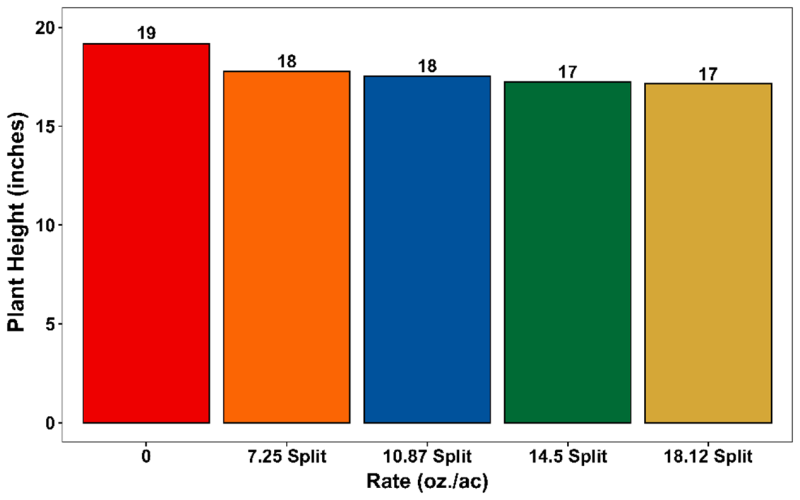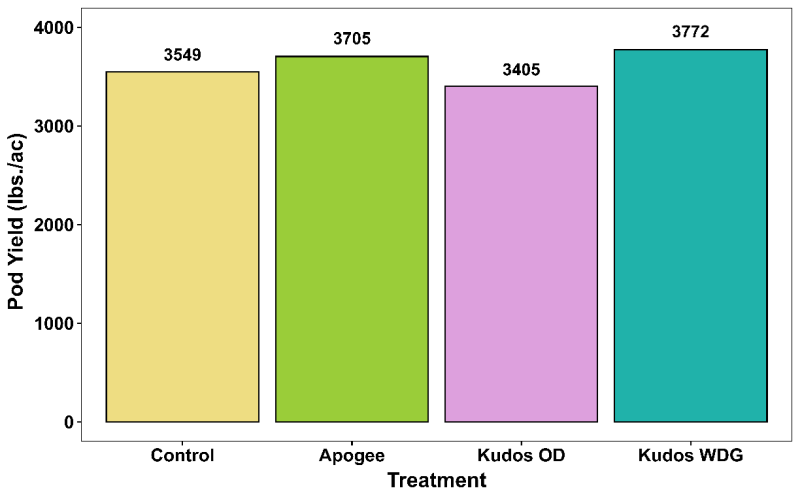Peanut production in Florida continues to evolve as growers seek new ways to maximize yield, improve quality, and manage plant health under diverse environmental conditions. One tool gaining attention is the use of plant growth regulators (PGRs), products that can influence crop development and help optimize plant architecture and productivity. Recent research suggests that strategic use of PGRs can offer important benefits when applied correctly, but understanding when, why, and how to use them is key to achieving consistent results. The most common PGRs in peanut production use the active ingredient prohexadione calcium, which is sold under different trade names such as Kudos® 27.5 WDG and Kudos-OD (sold by Fine Americas Inc). Previously the BASF product Apogee was common, but it has been discontinued this year.
–
Why Use Growth Regulators in Peanuts?
Vine growth in peanuts depends on variety, fertility, and weather. High-vigor cultivars like FloRun™’331, Georgia-12Y, and Georgia-16HO often produce excessive vegetative growth, especially under irrigated or high-fertility conditions. This can reduce airflow, increase disease risk, limit fungicide coverage, and make digging more difficult, especially when vines grow past the row middles.
Plant growth regulators (PGRs), such as prohexadione calcium, can help manage this by shortening internodes and creating a more compact canopy. This not only improves airflow and row visibility but also helps with accurate digging, reducing harvest losses. When applied at the right time and under proper conditions, PGRs can reduce vine length by up to 2 inches without affecting leaf count or yield potential. See Figure 1 and 2 for results in main stem height reduction in small plot trials at WFREC, Jay.

Fig 1. Visual difference of peanut canopy growth between PGR treated and untreated plot.
Credit: Satinderpal Singh (UF/IFAS)
–

Fig 2. Effect of different application rates of PGRs (Prohexadione calcium) on peanut plant height from trials conducted at WFREC, Jay in 2020-2022.
–
When Should Growth Regulators Be Applied?
Proper timing is essential for getting the most benefit from plant growth regulators (PGRs) in peanut production. The first application is typically made around 50% row closure—when about half of the lateral vines meet in the row middles—usually 55 to 65 days after planting. However, timing can vary depending on variety, growth rate, and weather conditions. In fast-growing fields or before forecasted rain, growers may apply earlier to stay ahead of excessive vine growth.
If a second application is needed, it’s usually made 14 days after the first, shortly after full row closure. Avoid spraying during drought stress, nutrient deficiencies, or visible disease pressure, as these conditions reduce effectiveness. For best results, ensure at least 8 rain-free hours after application to allow proper uptake into the plant. I would suggest checking the product label for appropriate timing of application.
–
Will you see yield benefits?
It depends!
The yield increase in response to application of PGRs in peanuts depends on several other factors such as what variety is being used, what are the weather conditions, thereby resulting in inconsistent results on yield increase. However, the results from WFREC trials show yield benefits of about 250 lbs/ acre. It is important to note that even 75% of the labeled rate delivered a similar or better yield performance (Table 1).
Table 1. Effect of different application rates of PGRs (Prohexadione calcium) on peanut pod yields from trials conducted at WFREC, Jay in 2020-2022.
| % of Label Rate | Total Season Rate (oz/ac) | No. of Applications | Rate per Split (oz/ac) | Application Timing | Average Yield (lbs./ac) |
| 0% | 0 | 0 | 0 | N/A | 6,135 |
| 50% | 7.25 | 2 | 3.63 | 1st Spray: at 50% closure
2nd Spray: 14 days after |
6,062 |
| 75% | 10.87 | 2 | 5.44 | 1st Spray: at 50% closure
2nd Spray: 14 days after |
6,375 |
| 100% | 14.5 | 2 | 7.25 | 1st Spray: at 50% closure
2nd Spray: 14 days after |
6,366 |
| 125% | 18.12 | 2 | 9.06 | 1st Spray: at 50% closure
2nd Spray: 14 days after |
5,925 |
–
Do new products perform similar to Apogee?
As the active ingredient is same, the answer is yes. In a separate trial at WFREC, we compared performance of Apogee, Kudos-OD and Kudos-WDG at 75% of the label rate (10.87 oz/ac). All treatments reduced plant height and increased yield compared to the untreated control except Kudos® OD (Figure 3).

Fig. 3. Comparison of plant height across different Prohexadione calcium products applied at a split rate of 10.87 oz/ac. Data are from the 2023–2024 WFREC, Jay trial.
–
Growers should consider the following before deciding to apply PGRs:
- Field History: If past seasons have shown excessive vine growth, delayed digging, or harvesting issues, the field may benefit from PGR use. Look for patterns of high biomass or digging losses.
– - Cultivar Selection: Certain varieties (such as newer high-vigor lines) naturally produce more vines. These types are the most likely to benefit from PGR applications.
– - Expected Rainfall: Wet seasons, or irrigated fields, promote vine growth. If forecasts predict abundant rainfall, a PGR can help manage the expected growth.
– - Soil Fertility: High nitrogen content, or overall fertility can encourage lush vine development. Pre-planting and in season soil testing can help identify any levels of high nutrient availability. Specifically, chicken litter applications have been noted to increase vine growth.
–
Wishing everyone a productive and healthy peanut growing season!
- Potential Winter Cover Crops and Best Management Practices - November 7, 2025
- Managing Peanut Vine Growth with Plant Growth Regulators - May 2, 2025
- Join the 2025 STEP Cotton Competition! - March 28, 2025
